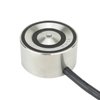WarmlyYours Snow Melt Sensor, Slab Mounted
Features
-
Detects Snow And Ice On Concrete Or Asphalt: Reliably detects snow and ice on concrete or asphalt when used in conjunction with the SCE-120 Economy Snow Melt Control, in particular, it detects moisture and temperature
-
Fastest Response: The SLAB-SS offers the fastest response time with the sensor in direct contact with the asphalt or concrete to be heated, sensor wire must remain separate from any high-voltage wire to avoid a distorted sensor signal
-
Mounts To The Snow-Melting Cable: The sensor mounts in close proximity to the snow-melting cable to ensure the pavement and sensor become dry at similar time intervals, maximum distance between the sensor and the control is 650 feet using 18 AWG wire
-
24/7 Technical Assistance: The WarmlyYours troubleshooting team is available 24/7 to provide technical assistance or support at 800-875-5285
Snow Melting Sensors Description
Thisslab-mounted snow sensor reliably detects snow and ice on concrete or asphaltwhen used in conjunction with the SCE-120 Economy Snow Melt Control. This sensor works by detecting moisture and temperature. The sensor mounts in close proximity to thesnow-melting cable to ensure the pavement and sensor become dry at similar time intervals.Maximum distance between the sensor and the control is 650 feet using 18 AWGwire. Note: Sensor wire must remain separate from any high-voltage wire toavoid a distorted sensor signal. Cannot be used as a replacement for ETOG-56.
Learn more about snow melting systems. Perfect for heated driveways, patios, walkways and paths, accessibility ramps, or even stairs.
Specifications
Electrical
| Activation Temperature | Set at the controller |
| Lead Length | 82′ |
| Sensitivity | Temperature and precipitation |
Installation
| Installation Area | Pavement |
Product Dimensions
| Length | 8.5″ |
| Weight | 3 lbs |
| Width | 8.5″ |
Identifiers
| SKU | SLAB-SS |
| UPC (GTIN-12) | 881308020620 |
Warranty / Certifications
| Warranty | 2 years |
Documents
Frequently Asked Questions
The material costs are similar. However, electric systems are easier to install, with fewer components and significantly lower maintenance costs. Electric systems will run for a shorter period of time to give the same level of performance but with much higher energy efficiency (typically 95%-98% efficient). Controls and sensors required for the two types of systems are very similar. Electric systems do not usually require slab insulation and do not create the concerns typically associated with hydronic systems. These concerns include, but are not limited to, return temperatures, flue gas venting, waterway shrinkage and property damage caused by leaking pipes or tubes.
When installing outdoor WarmlyYours snow melting cables for your driveway, patio, walkway, terrace, stairs, ramp, etc. - NEVER cross, overlap, or allow the heating cables to touch each other. Doing so will quickly cause a circuit failure due to excessive heat build up. Always follow the installation instructions and/or design layout plan to ensure the cable is installed with the correct spacing required for proper operation.
Our systems can handle low temperatures, but many controls come equipped with a Low-Temperature Lockout Feature. This feature prevents the system from running in very low temperatures. At very low temperatures it can become difficult for the system to effectively melt the snow. It is however possible to turn off this feature should you need the system to keep running during such low temperatures.


